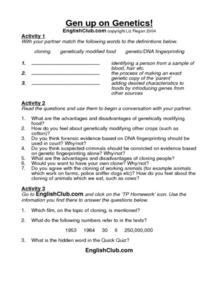Curated OER
Gel Electrophoresis: Sort and See the DNA
Students construct DNA fingerprints. In this genetics instructional activity, students watch an on-line gel electrophoresis animation, then they work in groups to use a restriction map to create a restriction enzyme and use that to...
Curated OER
Genome: The Secret of How Life Works
What do you have in common with a fruit fly? About 60 percent of your DNA. The resource, divided into two units, is intended for grades four to eight and another for high schoolers. Both units include eight lessons covering the...
Curated OER
DNA Questions
For this forensic science worksheet, students analyze the characteristics and uses of DNA to complete 26 short answer questions.
Curated OER
Gen Up on Genetics!
In this gen up on genetics learning exercise, students, with a partner, explore, examine, discuss and complete a variety of activities associated with genetics, DNA and cloning.
Curated OER
DNA Activities
Students work together to identify the structure of DNA. They practice using new vocabulary as well. They create a 3-D model of DNA to complete the lesson.
Curated OER
DNA Week
Students perform different activities about DNA for a week in order to celebrate DNA Week and raise their awareness of DNA. The teacher is provided with a different theme for each day.
Curated OER
Where's the CAT? a DNA Profiling Simulation.
Students explore DNA technology. Students participate in a simulation to perform at the basic steps of a DNA profile. They observe copies of DNA sequences, construct DNA probes, and discuss outcomes of their experiment.
Curated OER
Enzyme and Southern Blotting
Students study southern blotting and its uses. They research on restriction enzymes and their uses, especially in relation to recombinant DNA. In addition, they write a summary and an interpretation of the gel.
Curated OER
DNA Fingerprinting through a Chemistry Lens
Students explore DNA and restriction enzymes using fragments of DNA separated by electrophoresis on an agarose gel. They analyze the results to see "whodunit".
Curated OER
DNA Fingerprinting
Ninth graders investigate what restriction enzymes do, and explain how a DNA sample can link a suspect to a crime.
ConnectED
Crime Scene Investigation
How exactly does a crime scene investigation work? The resource, a unit on criminology, covers everything from the deductive reasoning skills needed for detectives to DNA fingerprinting, all the way to how to gather evidence and bring...
Curated OER
The Human Genome
In this human genome worksheet, students will complete a graphic organizer by writing in the different applications of the Human Genome Project. Then students will answer 3 true or false questions based on DNA fingerprinting and genetic...
Curated OER
Who's Who and How Do You Know for Sure?
Young scholars investigate the applications of DNA fingerprinting, They read crime scenarios and using the details of the crime and laboratory experimentation decide the suspects guilt or innocence.
Curated OER
Who Done It?
Pick and choose which activities to include in this crime scene investigation. Junior detectives can examine fingerprints, DNA, blood samples, or bone structure. The plan suggests you have teams solve a mystery, but it does not...
Curated OER
Who Is It?/Who Done It?
Students conduct an experiment that allows them to assess individual differences in random DNA sequences and apply those differences when solving a forensic problem. After discussing the polymerase chain reaction and its use to identify...
Curated OER
Polymerase Chain Reaction (PCR)
Students explore how PCR works through various activities. In this biology lesson, students explain how PCR generate copies of DNA. They simulate the process using an online interactive website.
Curated OER
What is Forensic Science? Website and Worksheets
For this science website and worksheets, students read the definitions and applications of forensic science. They read about DNA, fingerprints, and handwriting analysis. They carry out an ink chromatography experiment and record the...
Curated OER
Genetic Technology
In this genetic technology activity, students will answer 6 true or false statements and 4 short answer questions based on the mapping and sequencing of the human genome and the applications of the Human Genome Project.
Curated OER
And the Verdict Is...
Students identify the unique pattern DNA forms in each individual, and how that pattern can be used to identify criminals. They have the opportunity to simulate the process of matching DNA samples to those taken at a crime scene.
Curated OER
Genetics and Heredity: The Next Generation
Tenth graders work in teams to order events of DNA transcription and translation protein synthesis. In the second lesson, they put the steps of mitosis and meiosis in order using a concept map poster. They use modeling clay to create...
Curated OER
DNA Fingerprinting
Students experiment with chromatography as a technique which is similar to electrophoresis that scientists use to identify DNA samples.
Curated OER
What Does That DNA Molecule Really Look Like???
Students extract DNA from animal liver cells. They separate, collect and describe the appearance from the extracted DNA while role playing as an intern in a city's forensics.
Curated OER
Lost Tribes of Israel
Young scholars examine the issues involved with using DNA evidence in a courtroom trial. They read and discuss a case study of a particular trial, conduct research, and role-play a jury by reporting their verdict and discussing how they...
Tutor 2 U
Plan for the Murder Solving Lesson
It's a classic case of whodunnit - with a forensic twist! Learners observe a crime scene and compile evidence, along with emergency phone calls, fingerprints, and interview statements to find the criminal and solve the crime.
Other popular searches
- Dna Fingerprinting Crime
- Dna Fingerprinting Lab
- Dna Fingerprinting Worksheet
- Dna Fingerprinting Grade 5
- Dna Fingerprinting Grade5
- Dna Fingerprinting Test
- Dna Fingerprinting Rape Case
- Dna Fingerprinting Photoshop
- Dna Fingerprinting Photo Shop

























